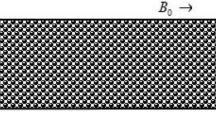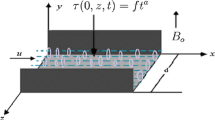Abstract
Porosity plays a significant role in controlling the wake dynamics behind a porous object. A porous object allows fluid to flow through it partially, which causes a reduction in the size of the wake behind the body. The wake dynamics can also be controlled by imposing an external magnetic field on an electrically conducting fluid. Keeping in view the above facts, numerical computations are performed to explore the coupled effect of the porosity and the magnetic field on the wake dynamics around a porous square cylinder. The cylinder is placed in a two-dimensional unconfined domain having a fictitious blockage ratio of 0.025. The Reynolds number is kept in the range 10–40 with Darcy number 10−6–10−2 and Hartmann number 0–8. The flow in the porous medium is modeled using the Darcy–Brinkman–Forchheimer model. The critical magnetic parameter for the complete suppression of the wake behind the cylinder for the given range of Darcy and Reynolds numbers is computed. The results show that the critical Hartmann number increases with the Reynolds number, whereas it decreases with the Darcy number. Another interesting finding is the estimation of the critical Hartmann number for the detachment of the recirculation region from the rear surface of the cylinder. The detachment Hartmann number increases with an increase in the Reynolds number and a decrease in the Darcy number.














Similar content being viewed by others
Abbreviations
- B :
-
Blockage ratio \(\left( { = D{/}H} \right)\)
- B 0 :
-
Magnetic field intensity (T)
- \(\overrightarrow {B}\) :
-
Magnetic field vector
- C D :
-
Drag coefficient
- \(d_{{\text{p}}}\) :
-
Characteristics diameter of particle (m)
- D :
-
Cylinder size (m)
- Da:
-
Darcy number \(\left( {{{ = K} \mathord{\left/ {\vphantom {{ = K} {D^{2} }}} \right. \kern-\nulldelimiterspace} {D^{2} }}} \right)\)
- F Lorentz :
-
Lorentz force (N)
- H :
-
Width of computational domain (m)
- Ha:
-
Hartmann number \(\left( { = B_{0} D\sqrt {{\sigma \mathord{\left/ {\vphantom {\sigma {\rho \eta }}} \right. \kern-\nulldelimiterspace} {\rho \eta }}} } \right)\)
- J :
-
Current density (amp/m2)
- K :
-
Permeability (m2)
- L :
-
Length of computational domain (m)
- L d :
-
Downstream length (m)
- L r :
-
Dimensionless bubble length \(\left( {{{ = \overline{{L_{r} }} } \mathord{\left/ {\vphantom {{ = \overline{{L_{r} }} } D}} \right. \kern-\nulldelimiterspace} D}} \right)\)
- L u :
-
Upstream length (m)
- N :
-
Stuart number \(\left( { = {{{\text{Ha}}^{2} } \mathord{\left/ {\vphantom {{{\text{Ha}}^{2} } {\text{Re}}}} \right. \kern-\nulldelimiterspace} {\text{Re}}}} \right)\)
- p :
-
Dimensionless pressure \(\left( { = {{\overline{p} } \mathord{\left/ {\vphantom {{\overline{p} } {\rho \,u_{\infty }^{2} }}} \right. \kern-\nulldelimiterspace} {\rho \,u_{\infty }^{2} }}} \right)\)
- Pr:
-
Prandtl number \(\left( { = {\eta \mathord{\left/ {\vphantom {\eta \alpha }} \right. \kern-\nulldelimiterspace} \alpha }} \right)\)
- Re:
-
Reynolds number \(\left( { = {{u_{\infty } D} \mathord{\left/ {\vphantom {{u_{\infty } D} \eta }} \right. \kern-\nulldelimiterspace} \eta }} \right)\)
- \(u_{\infty }\) :
-
Freestream velocity (m/s)
- u :
-
Dimensionless axial velocity \(\left( { = {{\overline{u} } \mathord{\left/ {\vphantom {{\overline{u} } {u_{\infty } }}} \right. \kern-\nulldelimiterspace} {u_{\infty } }}} \right)\)
- \(\overrightarrow {V}\) :
-
Velocity vector (m/s)
- v :
-
Dimensionless normal velocity \(\left( { = {{\overline{v} } \mathord{\left/ {\vphantom {{\overline{v} } {u_{\infty } }}} \right. \kern-\nulldelimiterspace} {u_{\infty } }}} \right)\)
- \(v\) :
-
Darcy velocity (m/s)
- x :
-
Dimensionless axial coordinate \(\left( { = {{\overline{x} } \mathord{\left/ {\vphantom {{\overline{x} } D}} \right. \kern-\nulldelimiterspace} D}} \right)\)
- y :
-
Dimensionless normal coordinate \(\left( { = {{\overline{y} } \mathord{\left/ {\vphantom {{\overline{y} } D}} \right. \kern-\nulldelimiterspace} D}} \right)\)
- \(\alpha\) :
-
Thermal diffusivity of fluid (m2/s)
- ε :
-
Porosity
- \(\Lambda\) :
-
Viscosity ratio (= \({{\mu_{{\text{e}}} } \mathord{\left/ {\vphantom {{\mu_{{\text{e}}} } \mu }} \right. \kern-\nulldelimiterspace} \mu }\))
- \(\eta\) :
-
Kinematic viscosity of fluid (m2/s)
- \(\mu\) :
-
Dynamic viscosity of fluid (Pa s)
- \(\rho\) :
-
Density of fluid (kg/m3)
- \(\sigma\) :
-
Electrical conductivity of fluid (S/m)
- ∞ :
-
Freestream
- e:
-
Effective
- –:
-
Dimensional quantity
References
Anirudh, K., Dhinakaran, S.: On the onset of vortex shedding past a two-dimensional porous square cylinder. J. Wind Eng. Ind. Aerodyn. 179, 200–214 (2018). https://doi.org/10.1016/j.jweia.2018.03.004
Ansys Inc.: Ansys Fluent 15.0: Theory Guide. (2010)
Bhattacharya, A., Raja Sekhar, G.P.: Potential flow past a slightly deformed porous circular cylinder. Transp. Porous Med. 81, 367–389 (2010). https://doi.org/10.1007/s11242-009-9409y
Bhattacharyya, S., Dhinakaran, S., Khalili, A.: Fluid motion around and through a porous cylinder. Chem. Eng. Sci. 61, 4451–4461 (2006). https://doi.org/10.1016/j.ces.2006.02.012
Bovand, M., Rashidi, S., Dehghan, M., Esfahani, J.A., Valipour, M.S.: Control of wake and vortex shedding behind a porous circular obstacle by exerting an external magnetic field. J. Magn. Magn. Mater. 385, 198–206 (2015). https://doi.org/10.1016/j.jmmm.2015.03.012
Bovand, M., Rashidi, S., Esfahani, J.A., Saha, S.C., Gu, Y.T., Dehesht, M.: Control of flow around a circular cylinder wrapped with a porous layer by magnetohydrodynamic. J. Magn. Magn. Mater. 401, 1078–1087 (2016). https://doi.org/10.1016/j.jmmm.2015.11.019
Chatterjee, D., Kumar, C.: On the disappearance of the steady wake region behind porous objects under freestream flow at low Reynolds numbers. J. Fluids Eng. (2021). https://doi.org/10.1115/1.4051405
Chatterjee, D., Mondal, B.: Effect of thermal buoyancy on vortex shedding behind a square cylinder in cross flow at low Reynolds numbers. Int. J. Heat Mass Transf. 54, 5262–5274 (2011). https://doi.org/10.1016/j.ijheatmasstransfer.2011.08.016
Chatterjee, D., Mondal, B.: Control of flow separation around bluff obstacles by superimposed thermal buoyancy. Int. J. Heat Mass Transf. 72, 128–138 (2014). https://doi.org/10.1016/j.ijheatmasstransfer.2014.01.013
Chatterjee, D., Chatterjee, K., Mondal, B.: Control of flow separation around bluff obstacles by transverse magnetic field. J. Fluids Eng. Trans. ASME. 134, 1–11 (2012). https://doi.org/10.1115/1.4007316
Chen, X., Yu, P., Winoto, S.H., Low, H.T.: Numerical analysis for the flow past a porous square cylinder based on the stress-jump interfacial-conditions Int. J. Num. Methods Heat Fluid Flow 18(5), 635–655 (2008). https://doi.org/10.1108/09615530810879756
Dhinakaran, S., Ponmozhi, J.: Heat transfer from a permeable square cylinder to a flowing fluid. Energy Convers. Manag. 52, 2170–2182 (2011). https://doi.org/10.1016/j.enconman.2010.12.027
Gozmen, B., Firat, E., Akilli, H., Sahin, B.: Flow control behind a circular cylinder via a porous cylinder in deep water. In: EPJ Web of Conferences (2013) https://doi.org/10.1051/epjconf/20134501035
Gupta, S.K., Ray, S., Chatterjee, D.: Influence of aiding buoyancy on the suppression of flow separation for power-law fluids around a circular object. Heat Transf. Eng. 37, 1267–1279 (2016). https://doi.org/10.1080/01457632.2015.1119603
Ichikawa, Y., Selvadurai, A.P.S.: Transport Phenomena in Porous Media. Springer, Berlin, Heidelberg (2012)
Kumar, C., Chatterjee, D., Mondal, B.: The role of cross thermal buoyancy in initiating vortex shedding behind a permeable square cylinder at low Reynolds numbers. J. Porous Med. 24, 65–84 (2021). https://doi.org/10.1615/JPORMEDIA.2021036458
Leal, L.G.: Vorticity transport and wake structure for bluff bodies at finite Reynolds numbers. Phy. Fluids A-Fluid. 1, 124–131 (1989). https://doi.org/10.1063/1.857540
Li, Z., Zhang, H., Liu, Y., McDonough, J.M.: Implementation of compressible porous–fluid coupling method in an aerodynamics and aeroacoustics code part I: laminar flow. Appl. Math. Comput. (2020). https://doi.org/10.1016/j.amc.2019.124682
Mimeau, C., Cottet, G.-H., Mortazavi, I.: Passive flow control around a semi-circular cylinder using porous coatings. Int. J. Flow Control. 6, 43–50 (2014). https://doi.org/10.1016/j.euromechflu.2017.03.002
Mimeau, C., Mortazavi, I., Cottet, G.H.: Passive control of the flow around a hemisphere using porous media. Eur. J. Mech.: B/fluids 65, 213–226 (2017). https://doi.org/10.1016/J.EUROMECHFLU.2017.03.002
Nield, D.A., Bejan, A.: Convection in Porous Media: Donald A. Springer, New York (2006)
Noymer, P.D., Glicksman, L.R., Devendran, A.: Drag on a permeable cylinder in steady flow at moderate Reynolds numbers. Chem. Eng. Sci. 53, 2859–2869 (1998). https://doi.org/10.1016/S0009-2509(98)00117-1
Odabaee, M., Hooman, K., Gurgenci, H.: Metal foam heat exchangers for heat transfer augmentation from a cylinder in cross-flow. Transp. Porous Med. 86, 911–923 (2011). https://doi.org/10.1007/s11242-010-9664-y
Ozkan, G.M., Firat, E., Akilli, H.: Passive flow control in the near wake of a circular cylinder using attached permeable and inclined short plates. Ocean Eng. 134, 35–49 (2017). https://doi.org/10.1016/j.oceaneng.2017.02.014
Pinar, E., Ozkan, G.M., Durhasan, T., Aksoy, M.M., Akilli, H., Sahin, B.: Flow structure around perforated cylinders in shallow water. J. Fluids Struct. 55, 52–63 (2015). https://doi.org/10.1016/j.jfluidstructs.2015.01.017
Rashidi, S., Bovand, M., Pop, I., Valipour, M.S.: Numerical simulation of forced convective heat transfer past a square diamond-shaped porous cylinder. Transp. Porous Media. 102, 207–225 (2014). https://doi.org/10.1007/s11242-014-0272-0
Rashidi, S., Bovand, M., Esfahani, J.A., Öztop, H.F., Masoodi, R.: Control of wake structure behind a square cylinder by magnetohydrodynamics. J. Fluids Eng. Trans. ASME 137, 1–8 (2015a). https://doi.org/10.1115/1.4029633
Rashidi, S., Nouri-Borujerdi, A., Valipour, M.S., Ellahi, R., Pop, I.: Stress-jump and continuity interface conditions for a cylinder embedded in a porous medium. Transp. Porous Med. 107, 171–186 (2015b). https://doi.org/10.1007/s11242-014-0431-3
Rashidi, S., Hayatdavoodi, M., Esfahani, J.A.: Vortex shedding suppression and wake control: a review. Ocean Eng. 126, 57–80 (2016). https://doi.org/10.1016/j.oceaneng.2016.08.031
Singha, S., Sinhamahapatra, K.P., Mukherjea, S.K.: Control of vortex shedding from a bluff body using imposed magnetic field. J. Fluids Eng. Trans. ASME. 129, 517–523 (2007). https://doi.org/10.1115/1.2717616
Sohankar, A., Norberg, C., Davidson, L.: Low-Reynolds-number flow around a square cylinder at incidence: study of blockage, onset of vortex shedding and outlet boundary condition. Int. J. Num. Methods Fluids 26(1), 28–56 (1998). https://doi.org/10.1002/(sici)1097-0363(19980115)26:1%3c39::aid-fld623%3e3.3.co;2-g
Vafai, K., Kim, S.J.: On the limitations of the Brinkman–Forchheimer-extended Darcy equation. Int. J. Heat Fluid Flow 16, 11–15 (1995). https://doi.org/10.1016/0142-727X(94)00002-T
Vafai, K., Tien, C.L.: Boundary and inertia effects on flow and heat transfer in porous media. Int. J. Heat Mass Transf. 24, 195–203 (1981). https://doi.org/10.1016/0017-9310(81)90027-2
Vahedi, S.M., Zare Ghadi, A., Valipour, M.S.: Application of response surface methodology in the optimization of magneto-hydrodynamic flow around and through a porous circular cylinder. J. Mech. 34, 695–710 (2018). https://doi.org/10.1017/jmech.2018.1
Valipour, M.S., Rashidi, S., Bovand, M., Masoodi, R.: Numerical modeling of flow around and through a porous cylinder with diamond cross section. Eur. J. Mech. B/Fluids 46, 74–81 (2014a). https://doi.org/10.1016/j.euromechflu.2013.12.007
Valipour, M.S., Rashidi, S., Masoodi, R.: Magnetohydrodynamics flow and heat transfer around a solid cylinder wrapped with a porous ring. J. Heat Transf. 136, 1–10 (2014b). https://doi.org/10.1115/1.4026371
Vijaybabu, T.R., Anirudh, K., Dhinakaran, S.: Mixed convective heat transfer from a permeable square cylinder: a lattice Boltzmann analysis. Int. J. Heat Mass Transf. 115, 854–870 (2017). https://doi.org/10.1016/j.ijheatmasstransfer.2017.08.033
Vijaybabu, T.R., Anirudh, K., Dhinakaran, S.: LBM simulation of unsteady flow and heat transfer from a diamond-shaped porous cylinder. Int. J. Heat Mass Transf. 120, 267–283 (2018). https://doi.org/10.1016/j.ijheatmasstransfer.2017.11.010
Yu, P., Zeng, Y., Lee, T.S., Chen, X.B., Low, H.T.: Steady flow around and through a permeable circular cylinder. Comput. Fluids. 42, 1–12 (2011). https://doi.org/10.1016/j.compfluid.2010.09.040
Yu, S., Yu, P., Tang, T.: Effect of thermal buoyancy on flow and heat transfer around a permeable circular cylinder with internal heat generation. Int. J. Heat Mass Transf. 126, 1143–1163 (2018). https://doi.org/10.1016/j.ijheatmasstransfer.2018.06.056
Author information
Authors and Affiliations
Contributions
DC contributed to conceptualization and writing—review and editing; CK and BM contributed to methodology, formal analysis and investigation; CK contributed to writing—original draft preparation; DC and BM supervised the study.
Corresponding author
Ethics declarations
Conflict of interest
The author's declared that they have no conflict of interest.
Additional information
Publisher's Note
Springer Nature remains neutral with regard to jurisdictional claims in published maps and institutional affiliations.
Rights and permissions
Springer Nature or its licensor (e.g. a society or other partner) holds exclusive rights to this article under a publishing agreement with the author(s) or other rightsholder(s); author self-archiving of the accepted manuscript version of this article is solely governed by the terms of such publishing agreement and applicable law.
About this article
Cite this article
Kumar, C., Chatterjee, D. & Mondal, B. Effect of Porosity and Transverse Magnetic Field on the Wake Separation and Detachment around a Porous Square Cylinder. Transp Porous Med 146, 805–825 (2023). https://doi.org/10.1007/s11242-022-01889-y
Received:
Accepted:
Published:
Issue Date:
DOI: https://doi.org/10.1007/s11242-022-01889-y




